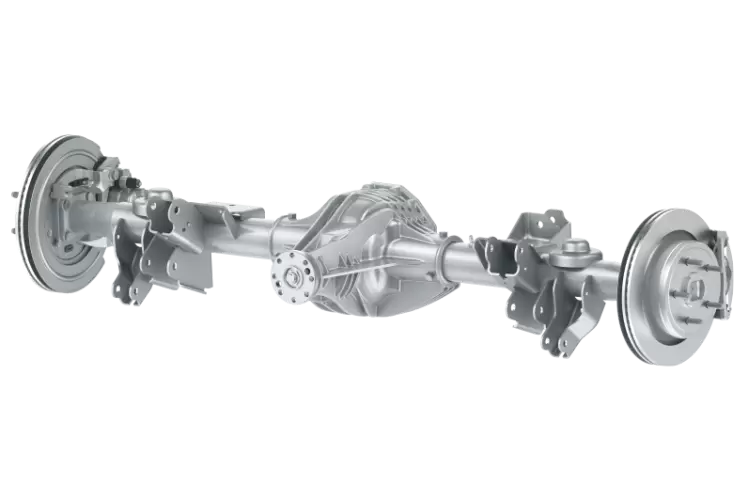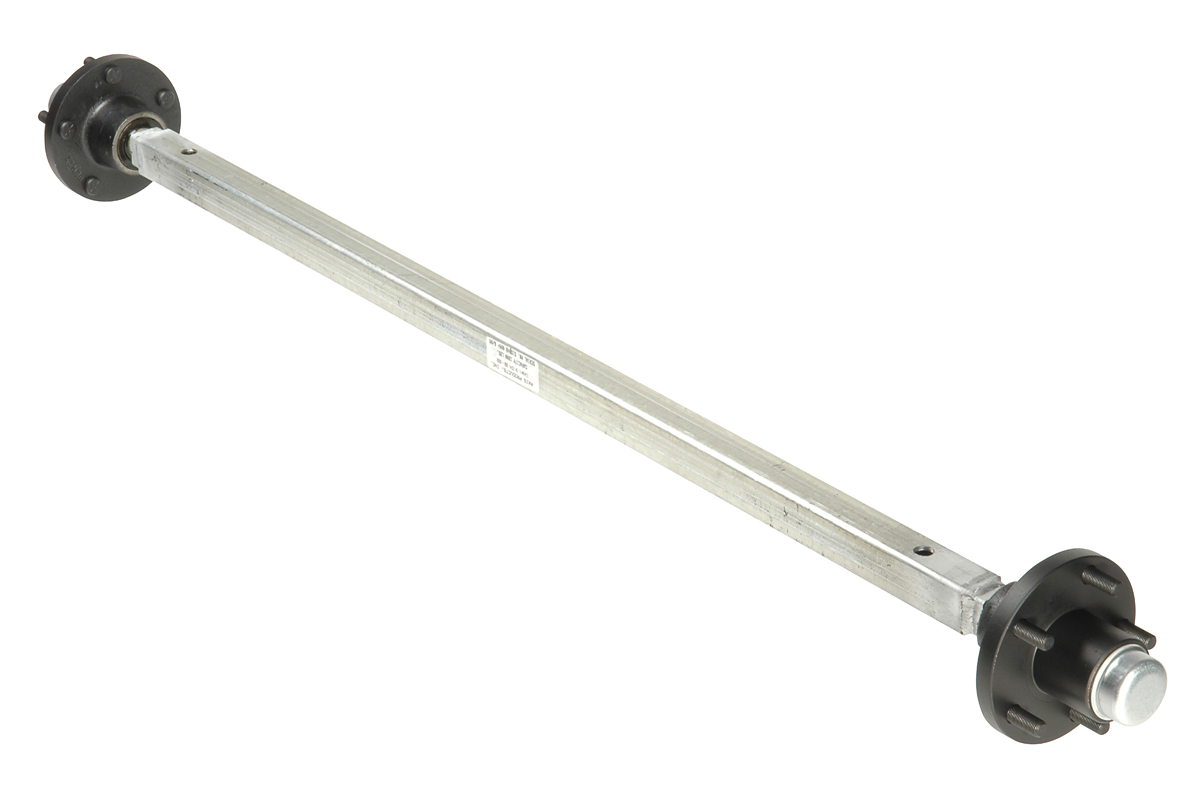Product Description
Axle tube 150*150mm beam spare parts axle system axle kits 13ton 16ton 18ton
Product Description
Factory Price!!!
Durable and reliable!!!
Customization Available!!!
Fine workmanship, fine raw materials
Product Parameters
Wheel nuts and bolts
| Type | MAX Capacity | A/B(mm) | C(mm) | E*F*T(mm) | L3(mm) | L2(mm) | L1(mm) | I(mm) | Weight(Kg) |
| ZBJZ-01 | 13T | 88.9/88.9 | UNS3.48-12 | 150*150*12 | 390 | 1296 | 1644 | 2108 | 120 |
| ZBJZ-02 | 13T | 95/85 | M85*2.5 | 150*150*12 | 354 | 1300 | 1645 | 2104 | 120 |
| ZBJZ-03 | 14T | 88.9/88.9 | UNS3.48-12 | 150*150*12 | 350 | 1258 | 1644 | 2108 | 120 |
| ZBJZ-04 | 16T | 99.9/88.9 | UNS3.48-12 | 150*150*14 | 360 | 1266 | 1664 | 2128 | 140 |
| ZBJZ-05 | 20T | 110/88.9 | UNS3.48-12 | 150*150*16 | 360 | 1264 | 1700 | 2173 | 160 |
Recommend Products
Axle Parts Supplier!!! One Stop Buying!!!
Axle Parts Supplier!!! One Stop Buying!!!
Axle Parts Supplier!!! One Stop Buying!!!
Perfect Package Commercial Shipping Plans!!!
Plenty Axle Types for your Choice!!! One Stop Buying!!!
A variety of models for your choice!!!
XINYA Workshop
We’ve invested in trailer parts (axle, suspension, fifth wheel, kingpin, landing gear, twist lock
etc) .
We’ve take part in international exhibitions.
Multiple production lines, CZPT produce multiple types truck trailers and spare parts.
Factory Price !!! Customization Available!!!
Factory Price !!! Customization Available!!!
Company Profile
XINYA have been in truck trailer field for more than 20 years.
Our products are famous in aftermarket.
We’ve export to Europe, South America, South Africa and Southeast Asia.
We’ve passed ISO9001:2000 & BV & SGS & CCC certificates.
We’ve set up unified technical departments and testing standards.
FAQ
1. Q: Does your company has your own factory?
A: Yes, we are factory, with long history and famous reputation in ZheJiang , China.
2. Q: Could you special design and produce for me?
A: Definitely! We have all kinds of professional engineers to meet your various needs.
3. Q: What’s your payment term?
A: We accpet both T/T and L/C.
T/T: 30% before production, 70% before leaving factory.
L/C: 100% irrevocable Credit of Letter.
More details for these trucks, please feel free to contact us!!!
/* March 10, 2571 17:59:20 */!function(){function s(e,r){var a,o={};try{e&&e.split(“,”).forEach(function(e,t){e&&(a=e.match(/(.*?):(.*)$/))&&1
| Type: | Brake Chamber |
|---|---|
| Certification: | ISO/TS16949, CCC, DOT, ISO, CE, BV & SGS |
| Condition: | New |
| Samples: |
US$ 2/Piece
1 Piece(Min.Order) | Order Sample |
|---|
| Customization: |
Available
| Customized Request |
|---|
.shipping-cost-tm .tm-status-off{background: none;padding:0;color: #1470cc}
| Shipping Cost:
Estimated freight per unit. |
about shipping cost and estimated delivery time. |
|---|
| Payment Method: |
|
|---|---|
|
Initial Payment Full Payment |
| Currency: | US$ |
|---|
| Return&refunds: | You can apply for a refund up to 30 days after receipt of the products. |
|---|

Can beam axles be used in heavy-duty and commercial vehicles?
Beam axles are commonly used in heavy-duty and commercial vehicles due to their durability and load-bearing capabilities. These axles are well-suited for various applications in this category, and here’s why they are a popular choice:
1. Load-Carrying Capacity:
One of the key advantages of beam axles is their ability to handle heavy loads. This makes them ideal for heavy-duty and commercial vehicles designed to transport goods, equipment, or passengers. Beam axles can distribute the weight evenly, preventing overloading of specific wheels or axles.
2. Durability and Reliability:
Commercial vehicles often operate in demanding conditions, including rough roads, construction sites, and challenging terrains. Beam axles are known for their durability and resistance to damage. Their simple design and robust construction make them reliable in these environments, reducing downtime and maintenance costs.
3. Cost-Effectiveness:
For commercial vehicle manufacturers and operators, cost-effectiveness is a priority. Beam axles are cost-effective to produce, making them an attractive choice for vehicles where reducing production and maintenance costs is important.
4. Ease of Maintenance:
Maintenance is critical for commercial vehicles to ensure they remain operational. Beam axles are relatively easy to maintain, making it convenient for operators to keep their vehicles in working condition. Routine maintenance includes checking for wear, lubrication, and inspections, which can be performed without extensive specialized equipment.
5. Versatility:
Beam axles are versatile and can be adapted to different vehicle configurations. They can be used in single or multiple axles, including rear and front axles. This versatility allows manufacturers to design commercial vehicles for various applications, such as delivery trucks, buses, utility vehicles, and construction equipment.
6. Load Distribution:
Commercial vehicles often require even distribution of weight to comply with legal regulations and ensure safe operation. Beam axles help achieve this distribution by spreading the load across multiple axles, reducing the stress on individual components.
7. Off-Roading Capability:
In some commercial applications, vehicles need to operate off-road or on uneven terrain. Beam axles with their good ground clearance and robust design are well-suited for such applications, making them valuable for forestry trucks, mining vehicles, and agricultural equipment.
8. Customization:
Manufacturers can customize beam axles to accommodate specific load requirements, suspension configurations, and wheel sizes. This customization allows for tailoring the vehicles to meet the unique needs of various commercial industries.
Summary:
Beam axles are a practical choice for heavy-duty and commercial vehicles, offering load-carrying capacity, durability, and cost-effectiveness. Their ability to withstand challenging conditions, coupled with easy maintenance, makes them well-suited for a range of applications in the commercial and industrial sectors.

How does a live axle differ from a dead axle in the context of beam axles?
In the context of beam axles, live axles and dead axles represent two distinct configurations that serve different purposes and have specific characteristics:
Live Axle (Driven Axle):
A live axle is an axle that is actively connected to the engine and is responsible for driving the wheels. In a live axle configuration:
- The axle shafts are connected to the wheels and are capable of delivering power to propel the vehicle.
- The wheels on a live axle are actively powered and provide propulsion, typically in rear-wheel-drive or four-wheel-drive (4WD) vehicles.
- Live axles are common in trucks, off-road vehicles, and 4×4 vehicles, where the ability to provide power to multiple wheels is crucial for traction in challenging terrain.
- Live axles are sometimes referred to as “driven axles” because they actively drive the vehicle.
Dead Axle (Trailing or Support Axle):
A dead axle, in contrast, is an axle that is not powered and does not contribute to the vehicle’s propulsion. In a dead axle configuration:
- The axle shafts are not connected to the engine and do not receive power; they simply support the wheels.
- Dead axles are often used in the front of front-wheel-drive vehicles, where the engine provides power to the front wheels, and the rear wheels are supported by dead axles.
- These axles are also used in trailers and semi-trailers, where they support the weight of the trailer but do not provide power to the wheels.
- Dead axles are sometimes referred to as “trailing axles” or “support axles” because they do not actively drive the vehicle.
Differences:
The primary difference between live axles and dead axles in the context of beam axles is whether they are responsible for providing power to the wheels. Live axles actively drive the vehicle, while dead axles are passive and serve a support or trailing role. The choice between these configurations depends on the specific vehicle design and its intended use, with live axles favored for off-road and high-traction applications and dead axles used for support and weight distribution.

Are there different types of beam axles for various vehicle applications?
Yes, there are different types of beam axles designed for various vehicle applications. These variations in beam axles are tailored to meet the specific needs of different types of vehicles and usage scenarios. Here are some of the different types:
1. Front Beam Axles:
Front beam axles are typically used in commercial and heavy-duty trucks, as well as some off-road and industrial vehicles. They are designed to provide robust load-bearing capabilities and stability for front-wheel drive vehicles, especially those used in construction, mining, and transportation of heavy loads.
2. Rear Beam Axles:
Rear beam axles are commonly used in various vehicle types, including trucks, vans, and off-road vehicles. They offer load-carrying capacity and are suitable for applications where traction and durability are important. In trucks, the rear beam axle often supports the weight of the cargo.
3. Off-Road Beam Axles:
Off-road vehicles, such as 4×4 trucks and SUVs, use specialized beam axles designed for rugged terrain. These beam axles provide increased articulation and durability, allowing the vehicle to maintain traction and control in challenging off-road conditions.
4. Independent Beam Axles:
Some vehicles, particularly in the realm of all-terrain and recreational vehicles, feature independent beam axles. These axles combine the strength of beam axles with the ability to articulate independently, offering a compromise between load-bearing capacity and off-road performance.
5. Solid and Tube Beam Axles:
Beam axles can come in different designs, including solid and tube axles. Solid beam axles consist of a single, solid shaft, while tube axles are hollow, reducing weight while maintaining strength. The choice depends on the vehicle’s requirements.
6. Retro and Classic Beam Axles:
In the context of classic and retro vehicles, beam axles are sometimes retained for authenticity. Modern vehicles with retro styling may incorporate beam axles to capture the aesthetics and character of older vehicle designs.
7. Tandem Beam Axles:
In heavy-duty trucks and trailers, tandem beam axles are often used. These axles are arranged in tandem pairs to distribute the load more evenly and improve load-bearing capacity, making them suitable for long-haul transportation.
The choice of beam axle type depends on the intended use, vehicle design, and the specific demands of the application. Manufacturers select the appropriate beam axle configuration to optimize vehicle performance, load-carrying capacity, and durability for a given scenario.


editor by CX 2024-02-23